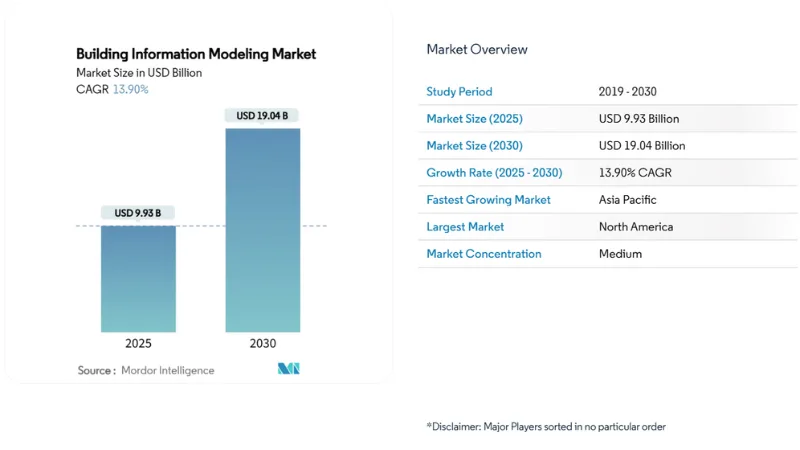Our team has dug into many industry reports and found clear evidence that construction is shifting fast. Digital tools now sit at the heart of how projects get designed, planned, built and maintained.

Around the globe, firms that apply modern workflows gain speed, make fewer mistakes, and control costs better. As we explore this blog, you are going to learn about the market size of the Building Information Modeling (BIM) space and how it pushes construction firms into new ways of working.

According to Mordor Intelligence in 2025, the BIM market is estimated at approximately USD 9.9 billion, with forecasts pointing toward over USD 19 billion by 2030. These numbers show a major shift: technology is no longer optional in construction, it is core. With infrastructure needs rising, sustainability targets pressing and global growth in construction spend, BIM is becoming a linchpin.
When you adopt BIM workflows, you pull design, build and operation teams into one shared picture. That shared picture helps cut waste, speed up delivery and reduce risk.
Understanding BIM and Its Core Importance
So what exactly is BIM? In plain terms, it means creating and using a digital model of the entire building or structure. That model brings together geometry, materials, schedules, cost and operational data.
Our research shows that this matters because it enables teams to see issues early, coordinate work better, and manage assets smarter.
Think of traditional construction: drawings on paper, hand-overs, and change orders. With BIM, you shift to models everyone works on, data that flows, and visibility across phases. That shift cuts errors, rework, and downtime. For you, that means better project outcomes, fewer cost overruns, and stronger operational performance.
In the sections ahead, you will get into the BIM market size more deeply, region-wise trends, what drives adoption, and how your company can use BIM to transform how it builds.

Key Trends Driving BIM Adoption
Our team has looked at many reports and found some major trends behind the rise of Building Information Modeling (BIM) adoption. One big trend is the shift to cloud-based platforms.
By 2025, around 48% of BIM deployments will use cloud tools that allow teams to collaborate in real time from anywhere.
Another trend is governments mandating BIM for public infrastructure.This pushes firms to adopt BIM fast to meet rules and gain access to large projects. We also see a push toward smarter workflows: integration of AI, automation, prefabrication and smarter data use.
For example, around 33% of firms use AI-powered design tools today. Sustainability also drives adoption. Many firms use BIM to model energy use, material waste, and carbon footprint.

That helps them meet green-building goals. Those trends show that BIM is no longer optional-it is becoming standard in construction.
How BIM Is Revolutionizing Global Construction
Our research shows how BIM changes construction around the world. With BIM, teams move from working in silos to working together under one digital model. That means less miscommunication, fewer errors, and faster approvals.
BIM also brings cost and time improvements. Some studies show BIM can reduce project rework by up to 45% and increase efficiency by around 42 %.

In India and other fast-growth markets, BIM use has cut construction costs by up to 20 % through better coordination. Globally, BIM helps teams visualise the full lifecycle of a building-from design to operation.
That means owners view how the building will perform long before it is built. For your company, that means fewer surprises on site, less waste, and stronger control of schedule and budget.
As you move into 2025, you will see BIM shift from a design tool to the backbone of how construction gets done worldwide.
Challenges in the BIM Market
Despite its clear benefits, BIM adoption faces a few real-world barriers.
- Skill gap – Many firms lack trained staff who can use BIM software properly. Without the right skills, tools often stay unused or misapplied.
- High setup cost – Small and medium firms hesitate because they fear the cost of new software, training, and upgrades.
- Data sharing issues – Different teams often use different tools, which can make file sharing and collaboration harder than it should be.
- Resistance to change – Some professionals still prefer traditional methods. They see BIM as complex or unnecessary.
- Limited awareness – In some regions, companies still do not know how BIM can raise productivity or meet government standards. This makes it even more important to choose the right BIM services provider who can guide teams, train staff, and help them unlock the full potential of digital construction.
These challenges can slow growth, but the direction remains clear. Every year, more construction firms take steps toward digital transformation.
Conclusion
The global construction industry now stands at a turning point, and BIM is leading this transformation. It has become the bridge between design ideas and real-world results. By connecting every team through one shared model, BIM services help reduce waste, save time, and raise project quality. Across the world, companies use it to bring accuracy, safety, and sustainability into every stage of construction.
At Next Syneargy Solution, our team believes BIM is not just a technology-it’s a smarter way to build. We see how digital collaboration removes confusion, how clear data drives better decisions, and how precise planning turns complex projects into success stories. The future of construction lies in integration, and BIM is the foundation that makes it possible.







